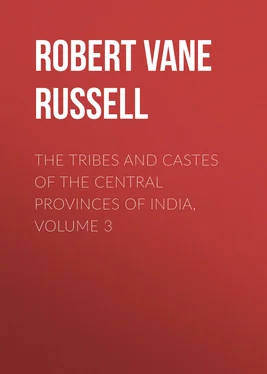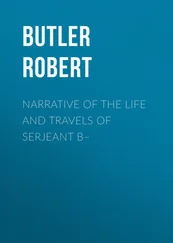Robert Vane Russell - The Tribes and Castes of the Central Provinces of India, Volume 3
Здесь есть возможность читать онлайн «Robert Vane Russell - The Tribes and Castes of the Central Provinces of India, Volume 3» — ознакомительный отрывок электронной книги совершенно бесплатно, а после прочтения отрывка купить полную версию. В некоторых случаях можно слушать аудио, скачать через торрент в формате fb2 и присутствует краткое содержание. Жанр: foreign_prose, История, foreign_edu, foreign_antique, на английском языке. Описание произведения, (предисловие) а так же отзывы посетителей доступны на портале библиотеки ЛибКат.
- Название:The Tribes and Castes of the Central Provinces of India, Volume 3
- Автор:
- Жанр:
- Год:неизвестен
- ISBN:нет данных
- Рейтинг книги:5 / 5. Голосов: 1
-
Избранное:Добавить в избранное
- Отзывы:
-
Ваша оценка:
- 100
- 1
- 2
- 3
- 4
- 5
The Tribes and Castes of the Central Provinces of India, Volume 3: краткое содержание, описание и аннотация
Предлагаем к чтению аннотацию, описание, краткое содержание или предисловие (зависит от того, что написал сам автор книги «The Tribes and Castes of the Central Provinces of India, Volume 3»). Если вы не нашли необходимую информацию о книге — напишите в комментариях, мы постараемся отыскать её.
The Tribes and Castes of the Central Provinces of India, Volume 3 — читать онлайн ознакомительный отрывок
Ниже представлен текст книги, разбитый по страницам. Система сохранения места последней прочитанной страницы, позволяет с удобством читать онлайн бесплатно книгу «The Tribes and Castes of the Central Provinces of India, Volume 3», без необходимости каждый раз заново искать на чём Вы остановились. Поставьте закладку, и сможете в любой момент перейти на страницу, на которой закончили чтение.
Интервал:
Закладка:
17. Marriage. Arrangement of matches
Marriage is generally adult. Among the wild Māria Gonds of Bastar the consent of the girl is considered an essential preliminary to the union. She gives it before a council of elders, and if necessary is allowed time to make up her mind. The boy must also agree to the match. Elsewhere matches are arranged by the parents, and a bride-price which amounts to a fairly substantial sum in comparison with the means of the parties is usually paid. But still the girls have a considerable amount of freedom. It is generally considered that if a girl goes of her own accord and pours turmeric and water over a man, it is a valid marriage and he can take her to live in his house. Married women also sometimes do this to another man if they wish to leave their husbands.
18. The marriage ceremony
The most distinctive feature of a Gond marriage is that the procession usually starts from the bride’s house and the wedding is held at that of the bridegroom, in contradistinction to the Hindu practice. It is supposed that this is a survival of the custom of marriage by capture, when the bride was carried off from her own house to the bridegroom’s, and any ceremony which was requisite was necessarily held at the house of the latter. But the Gonds say that since Dūlha Deo, the bridegroom god and one of the commonest village deities, was carried off by a tiger on his way to his wedding, it was decided that in future the bride must go to the bridegroom to be married in order to obviate the recurrence of such a calamity. Any risk incidental to the journey thus falls to the lady. Among the wilder Māria Gonds of Bastar the ritual is very simple. The bride’s party arrive at the bridegroom’s village and occupy some huts made ready for them. His father sends them provisions, including a pig and fowls, and the day passes in feasting. In the evening they go to the bridegroom’s house, and the night is spent in dancing by the couple and the young people of the village. Next morning the bride’s people go back again, and after another meal her parents bring her to the bridegroom’s house and push her inside, asking the boy’s father to take charge of her, and telling her that she now belongs to her husband’s family and must not come back to them alone. The girl cries a little for form’s sake and acquiesces, and the business is over, no proper marriage rite being apparently performed at all. Among the more civilised Mārias the couple are seated for the ceremony side by side under a green shed, and water is poured on them through the shed in imitation of the fertilising action of rain. Some elder of the village places his hands on them and the wedding is over. But Hindu customs are gradually being adopted, and the rubbing of powdered turmeric and water on the bodies of the bride and bridegroom is generally essential to a proper wedding. The following description is given of the Gonds of Kanker. On the day fixed for the marriage the pair, accompanied by the Dosi or caste priest, proceed to a river, in the bed of which two reeds five or six feet high are placed just so far apart that a man can lie down between them, and tied together with a thread at the top. The priest lies down between the reeds, and the bride and bridegroom jump seven times over his body. After the last jump they go a little way off, throw aside their wet clothes, and then run naked to a place where their dry clothes are kept; they put them on and go home without looking back. Among the Gonds in Khairāgarh the pair are placed in two pans of a balance and covered with blankets. The caste priest lifts up the bridegroom’s pan and her female relatives the bride’s, and walk round with them seven times, touching the marriage-post at each time. After this they are taken outside the village without being allowed to see each other. They are placed standing at a little distance with a screen between them, and liquor is spilt on the ground to make a line from one to the other. After a time the bridegroom lifts up the screen, rushes on the bride, gives her a blow on the back and puts the ring on her finger, at the same time making a noise in imitation of the cry of a goat. All the village then indulge in bacchanalian orgies, not sparing their own relations.
19. Wedding expenditure
In Bastar it is said that the expenses of a wedding vary from Rs. 5 to Rs. 20 for the bride’s family and from Rs. 10 to Rs. 50 for the bridegroom’s, according to their means. 61 61 One rupee = 1s. 4d.
In a fairly well-to-do family the expenditure of the bridegroom’s family is listed as follows: liquor Rs. 20, rice Rs. 12, salt Rs. 2, two goats Rs. 2, chillies Rs. 2, ghī Rs. 4, turmeric Rs. 2, oil Rs. 3, three cloths for the bride Rs. 8, two sheets and a loin-cloth for her relatives Rs. 5, payment to the Kumhār for earthen pots Rs. 5, the bride-price Rs. 10, present to the bride’s maternal uncle when she is not married to his son Rs. 2, and something for the drummers. The total of this is Rs. 76, and any expenditure on ornaments which the family can afford may be added. In wealthier localities the bride-price is Rs. 15 to 20 or more. Sometimes if the girl has been married and dies before the bride-price has been paid, her father will not allow her body to be buried until it is paid. The sum expended on a wedding probably represents the whole income of the family for at least six months, and often for a considerably longer period. In Chānda 62 62 From Mr. Langhorne’s monograph.
the bride’s party on arrival at the bridegroom’s village receive the Bara jawa or marriage greeting, every one present being served with a little rice-water, an onion and a piece of tobacco. At the wedding the bridegroom has a ring either of gold, silver or copper, lead not being permissible, and places this on the bride’s finger. Often the bride resists and the bridegroom has to force her fist open, or he plants his foot on hers in order to control her while he gets the ring on to her finger. Elsewhere the couple hold each other by the little fingers in walking round the marriage-post, and then each places an iron ring on the other’s little finger. The couple then tie strings, coloured yellow with turmeric, round each other’s right wrists. On the second day they are purified with water and put on new clothes. On the third day they go to worship the god, preceded by two men who carry a chicken in a basket. This chicken is called the Dhendha or associate of the bridal couple, and corresponds to the child which in Hindu marriages is appointed as the associate of the bridegroom. Just before their arrival at the temple the village jester snatches away the chicken, and pretends to eat it. At the temple they worship the god, and deposit before him the strings coloured with turmeric which had been tied on their wrists. In Chhindwāra the bride is taken on a bullock to the bridegroom’s house. At the wedding four people hold out a blanket in which juāri, lemons and eggs are placed, and the couple walk round this seven times, as in the Hindu bhānwar ceremony. They then go inside the house, where a chicken is torn asunder and the blood sprinkled on their heads. At the same time the bride crushes a chicken under her foot. In Mandla the bride on entering the marriage-shed kills a chicken by cutting off its head either with an axe or a knife. Then all the gods of her house enter into her and she is possessed by them, and for each one she kills a chicken, cutting off its head in the same manner. The chickens are eaten by all the members of the bride’s party who have come with her, but none belonging to the bridegroom’s party may partake of them. Here the marriage-post is made of the wood of the mahua tree, round which a toran or string of mango leaves is twisted, and the couple walk seven times round this. In Wardha the bride and bridegroom stand on the heap of refuse behind the house and their heads are knocked together. In Bhandāra two spears are placed on the heap of refuse and their ends are tied together at the top with the entrails of a fowl. The bride and bridegroom have to stand under the spears while water is poured over them, and then run out. Before the bride starts the bridegroom must give her a blow on the back, and if he can do this before she runs out from the spears it is thought that the marriage will be lucky. The women of the bride’s and bridegroom’s party also stand one at each end of a rope and have a competition in singing. They sing against each other and see which can go on the longest. Brāhmans are not employed at a Gond wedding. The man who officiates is known as Dosi, and is the bridegroom’s brother-in-law, father’s sister’s husband or some similar relative. A woman relative of the bride helps her to perform her part and is known as Sawāsin. To the Dosi and Sawāsin the bride and bridegroom’s parties present an earthen vessel full of kodon. The donors mark the pots, take them home and sow them in their own fields, and then give the crop to the Dosi and Sawāsin.
Интервал:
Закладка:
Похожие книги на «The Tribes and Castes of the Central Provinces of India, Volume 3»
Представляем Вашему вниманию похожие книги на «The Tribes and Castes of the Central Provinces of India, Volume 3» списком для выбора. Мы отобрали схожую по названию и смыслу литературу в надежде предоставить читателям больше вариантов отыскать новые, интересные, ещё непрочитанные произведения.
Обсуждение, отзывы о книге «The Tribes and Castes of the Central Provinces of India, Volume 3» и просто собственные мнения читателей. Оставьте ваши комментарии, напишите, что Вы думаете о произведении, его смысле или главных героях. Укажите что конкретно понравилось, а что нет, и почему Вы так считаете.












